‘The San Siro does not have architectural significance and can be demolished.’ Sorry…what?
The Italian heritage authority’s verdict, which arrived earlier this year, was met with a mix of bewilderment and dismay from the iconic stadium’s army of fans around the world. There had been rumours aplenty of AC Milan and Inter Milan proposing a new stadium over the years and, only last year, the clubs revealed two shortlisted designs. Surely, however, these proposals would be limited to a refurbishment, rather than the complete demolition, of the stadium christened ‘La Scala del Calcio’? Not so, it would seem. Although potential modifications to the proposals discuss retaining parts of the San Siro as a landmark (in the wider area’s proposed new sports and entertainment district) the stadium itself will be a brand new 60,000-seat arena.
Although not final, the Italian heritage authority’s verdict brings the possibility of the San Siro stadium being consigned to the history books a step closer. So why all the fuss? After all, moving to their own, state-of-the-art – and, crucially, club-owned – arena in 2011 has hardly done Juventus any harm. Put simply, in football terms, knocking down the San Siro would be like demolishing the most ornate cathedral or replacing the most unique, independent shop with a flat-packed chain store.
The San Siro stadium, named after the district around five kilometres north-west of Milan city centre, opened in 1926. In its earliest days, the stadium consisted of four separate stands and had a capacity of 35,000. The San Siro hosted three matches at the 1934 World Cup. Originally owned by Milan, the stadium was sold to the city in 1935. Ten years later, Inter joined Milan in playing their matches at the San Siro, which, by this point, had been redeveloped to consist of one fully enclosed tier.
Further expansion took place in the 1950s with the addition of a second tier, bringing the San Siro’s capacity to over 80,000. Access to the second tier is provided by helical ramps, which wrap around the stadium, giving the San Siro one of its many distinguishing features. In 1965, the stadium hosted the European Cup final (a 1-0 victory for Inter over Benfica) and again, five years later, it was chosen as the venue for European football’s showpiece club match (a 2-1 victory for Feyenord over Celtic).
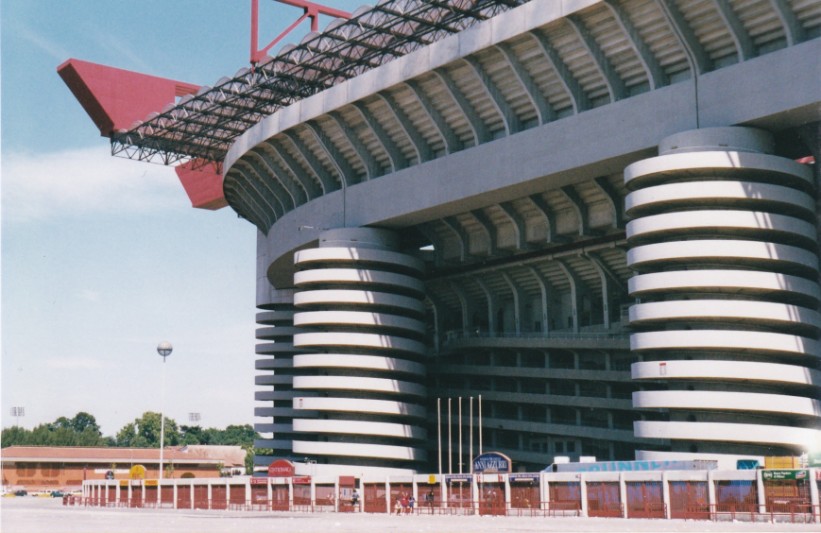
In 1980, the San Siro was officially renamed the Stadio Giuseppe Meazza after the man who starred for both Milan and Inter and was a two-times World Cup winner with the Italian national team. The same year, the stadium hosted three group matches during the European Championships, which were held in Italy.
The announcement that Italy had been chosen to host the 1990 World Cup brought the next stage of the San Siro’s development. Work on the construction of the stadium’s third tier, its enormous roof, complete with red girders, and 11 cylindrical towers began in 1987 (an excellent YouTube video (https://www.youtube.com/watch?v=fbFsFR3jScc&t=106s) highlights how this work was carried out). It was arguably these additions that earned the stadium its much-loved status; the towers are particularly striking. As well as providing access to the third tier via ramps, four of the towers, one in each corner of the stadium, support its roof.
Due to the adjacent San Siro racecourse, a third tier was not added to the stadium’s east side. The resulting gap between the east side’s second tier and roof affords a spectacular view of the city from the third tier of the west stand and, on a sunny day, a glimpse can be caught of a shining Madonnina statue perched atop Milan’s famous Duomo cathedral.
With renovations complete, the perfect setting was in place for Italia 90’s opening ceremony and first match between Argentina and Cameroon on June 8. Millions tuned in around the world fell in love with the spectacular arena on their TV sets, which, compared to the traditional British grounds of the time, looked like a stadium from another planet.
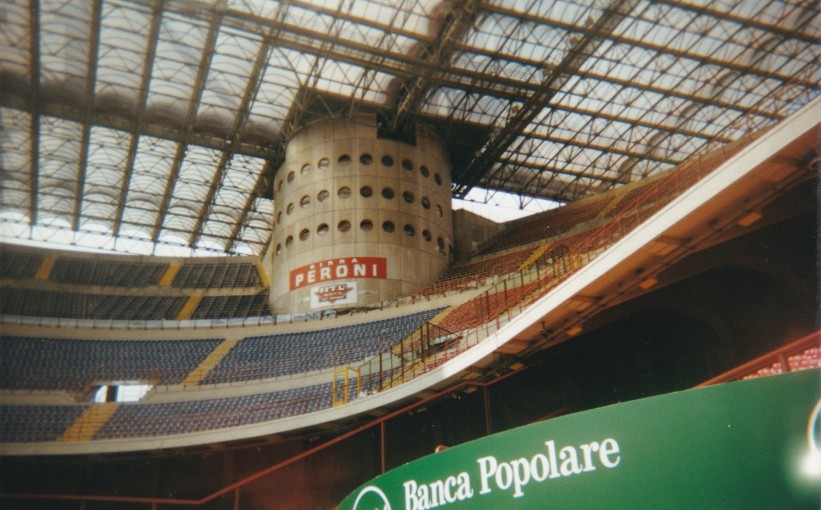
The Giuseppe Meazza hosted a further five games at Italia 90. Interestingly, all of these matches featured West Germany, who went on to win the tournament. The Round of 16 tie between the eventual winners and the Netherlands – as well as Cameroon’s surprise opening victory over World Cup holders Argentina – are, arguably, two of the most iconic matches to have been played at the San Siro.
My first visit to the San Siro arrived during a family summer holiday in 1998. With no respect for the difficulties of negotiating busy European city roads, my brothers and I always insisted that my dad take long detours if there was ever a football stadium within a 50-mile radius of our car (Turin’s Stadio delle Alpi, which, at the time, played host to Juventus and Torino’s home matches, had been ‘ticked off the list’ only a few days previously and Eindhoven’s Philips Stadion, home of PSV, was to follow a week later).
Driving through the streets of Milan, there was an almost tangible sense of excitement in the back of the car as the great stadium’s striking red roof girders crept into view over the city’s apartment blocks. We had made it! From the notti magiche of Italia 90 to Sunday afternoons tuned into Channel 4 watching the world’s best players strutting their stuff in this most fascinating of arenas, it was finally here in front of us. It was a roasting hot Sunday afternoon in Milan and I remember standing on the concourse totally entranced by the towers, ramps and the enormous roof. Incredible. Simply incredible. Though I’m not sure these were the words going through my mum’s head at the time. “It looks the same as the last one,” she would say whenever we stopped off at a new stadium. On this occasion, it certainly did not.
I’m not exactly sure how the next part played out but I recall my dad speaking to a staff member outside and suddenly we were going for a mini tour of the stadium. How official this was I don’t know, and I certainly didn’t care. We were going pitch-side!
Inside the stadium, I was even more mesmerised by its scale and beauty. Staring up at the roof and supporting towers at each corner (I always used to wonder if somebody was watching the action through the towers’ circular windows?) was like standing in a cathedral or museum in awe of the architecture and artwork.
I remember being told that we couldn’t take pictures of the pitch as it was being re-laid following a concert that summer. It really didn’t matter; being beside the pitch, touching the railings and sitting on the seats was plenty of excitement for my 13-year-old self. The World Cup in France was in full swing and, less than two months previously, Brazil’s Ronaldo, O Fenomeno, undoubtedly the football world’s biggest star during the second half of the decade, had been treating the 80,000 spectators at this magical arena to his spellbinding artistry.
During the 1997-98 Serie A season, Irish student Conor Delaney was one of those 80,000 mesmerised by Ronaldo’s performances in the black and blue of Inter. In addition to the entertainment on the park, Conor was taken aback by the sheer scale and unique charms of the San Siro.
“My first visit to the San Siro was in October 1997 for the derby between Inter and AC Milan,” Conor recalls. “I was an Erasmus student for the year in Italy and had spent six weeks from the end of August in the north of Italy in a small town called Feltre with 35 other European students studying Italian for six weeks before moving onto our destinations for the rest of the academic year. Myself and my mate Mark from Belfast went off to study in Florence and our good friend Pedro from Barcelona was sent to Milan. Pedro called us up to tell us he had a few tickets to the upcoming Milan derby and we didn’t need to think twice before hopping on the train to Milan that weekend.
“Both teams had world class line-ups, however the arrival of Ronaldo in Italy felt like a truly seismic era where we were lucky to be witnessing a truly special player. Everywhere Ronaldo played the stadiums were full and it was clear that this was the greatest player since Maradona. On the trams on the way to the stadium Pedro, after having watched Ronaldo the previous season in Barcelona, was at pains to convince both sets of Milanese supporters that they would witness something truly special, ‘you will see, you will see, you will see’ he repeated.
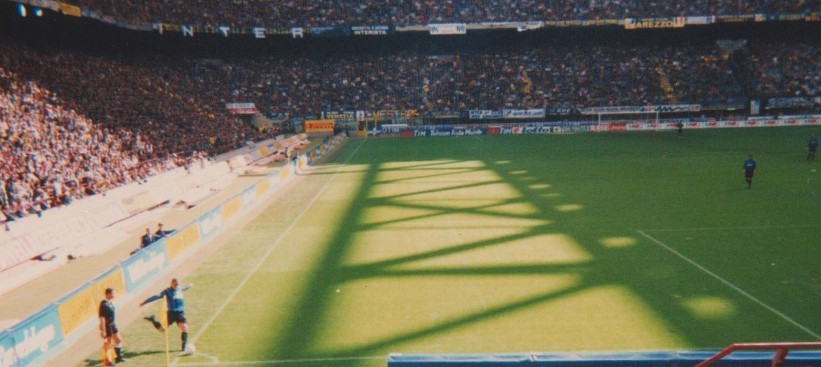
“When we arrived at San Siro itself, it was almost overwhelming. It was lit up like a spaceship, its height, the ramps, the roof; I don’t think there has been a stadium like it before or since. There was that raw, tense atmosphere of 90s Italian football before battle commenced and to add to the excitement a young ticketless teenage fan made a run for it and scaled the fence. The security chased him for a bit but gave up as he disappeared into the stadium itself – victory!”
Conor learned that evening that the stadium’s La Scala moniker not only reflects the San Siro’s beauty and status but also its impressive acoustics – and one player was doing his best to test the sound levels. “In the first five minutes Ronaldo picked up the ball on the halfway line and as he did so the crowd all around the stadium began to rise to their feet,” Conor recalls. “He went on a brilliant mazy run, the noise from the crowd rising all the time, before the ball was squared to Diego Simeone. Simeone put the ball in the net and then… bedlam! A cavernous roar erupted from the Inter fans the like of which I had never heard before, giving me the brividi (shivers). The echoey acoustics of the San Siro amplified the yells more than I have ever heard in any other stadium.”
The action didn’t stop after Simeone’s early opener. Three more goals followed – including a penalty for each side (Inter’s converted by Ronaldo) – and the match ended 2-2, Milan’s goals coming from George Weah and Andre Cruz from the penalty spot. The final whistle did not see Conor in any rush to leave the stadium, however. “I stood from the curva gazing out at the San Siro stands as they emptied, taking in every last moment before we left,” he remembers. “During the 1997-98 I was lucky to go four times to the San Siro to see Inter. Each experience was unique and memorable in its own way. It’s just the ultimate stadium and watching Ronaldo in his first year in Serie A, in the most perfect, packed arena, was a once-in-a-generation kind of event.”
Five years after my own pitch-side visit to the San Siro, it was time to take in a match for the first time. In 2003, and like Conor and his friends six years previously, the younger of my two older brothers was doing an Erasmus study abroad year and had chosen Milan as his base. This decision, of course, was based purely on the academic merits of his host institution and nothing at all to do with his love for Milan.

Within a fortnight of Gordon’s arrival in the city, I was making my first trip to visit him, and on Sunday 21 September 2003, I climbed the famous cylindrical stairwells up to the San Siro’s third tier. From my earliest days of going to football matches, I’ve been fascinated by the walk up the stairs and the moment when a new stadium, and the expanse of grass, reveals itself. It goes without saying that the San Siro didn’t disappoint on this front.
What did disappoint, however, was the action on the park that afternoon. Perhaps suffering a hangover from an excellent 0-3 Champions League victory at Arsenal four days earlier, Hector Cuper’s Inter Milan couldn’t break down a resolute Sampdoria side, and the game ended goalless.
Luckily for Gordon – and despite a sluggish start, and catastrophic end to their own Champions League campaign – the 2003-04 Serie A season was one to remember for the Rossoneri. The San Siro provided the perfect backdrop to a series of stunning displays from Kaka, Andriy Shevchenko, Andrea Pirlo and Clarence Seedorf, as AC Milan overpowered all domestic competition to secure the club’s 17th Scudetto.
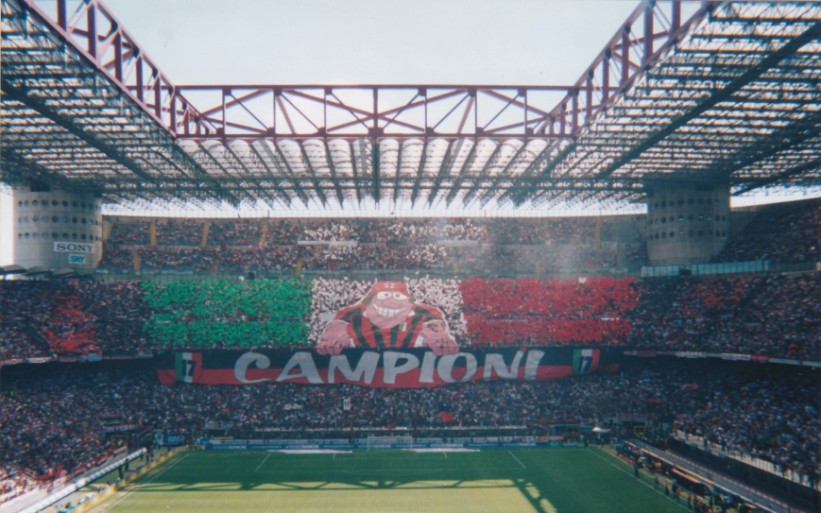
Gordon’s first match at the San Siro was AC Milan’s opening Champions League game of the 2003-04 campaign. Ajax were the opponents that evening and Gordon describes the experience as ‘quite literally, a dream come true’. “Growing up watching Football Italia and Gazzetta, the magical world of Italian football seemed like another planet to a 10-year-old child,” he says. “A far-off land which just seemed so unattainable. The San Siro, with its iconic red girders and windowed towers on each corner, housing a cacophony of sound and mesmerising pyrotechnics, was very much the epicentre of that world and the stage where I’d watched so much of that magic unfold in the Fabio Cappello years with Van Basten, Gullit, Rijkaard et al.”
Clearly a trait that runs in the family, Gordon also tingles with excitement as he recalls that magical and unique moment of emerging into a new arena for the first time. It’s a difficult feeling to put into words, but Gordon tries. “The chanting grew louder and louder as we ascended the ramp to the ‘secondo anello’ and my friends and I gasped in unison as we emerged into the arena, facing the ultras with their pageantry, pyrotechnics and passion in full view,” he says. Like my own first match, the game itself, another 0-0 draw, did not live up to the anticipation and pre-match excitement, but this mattered little for Gordon. “I spent the 90 minutes mesmerised at the theatre in the stands and the talent on the pitch…living a dream,” he recalls. “I even managed a special souvenir from the occasion – a golf ball from the visiting fans down below, thrown up in my direction and narrowly missing my cheekbone!”
Asked for his favourite footballing moment witnessed at the San Siro, Gordon mentions the lethal goalscoring of Shevchenko, the ‘mesmerising brilliance’ of Pirlo at his best and Kaka’s debut season in Milan, when the Brazilian was, for large parts of the campaign, simply out of this world. There’s also the sight of the great and unflappable Paolo Maldini executing a ‘Cruyff turn’ to free himself from danger on his own six-yard-line. However, the ultimate moment he picks out is a winning Milan derby goal in February 2004 from the Dutchman Seedorf – a strike Gordon describes as ‘preposterous’. “Despite dominating the first half, Milan found themselves, inexplicably, 2-0 down at half-time due to a couple of freakish goals from Inter set pieces,” he recalls. “Irrespective of the scoreline, there was a quiet confidence among the Rossoneri support as the gulf in class between the two sides was clearly evident. The deficit was quickly redressed within the first 20 minutes of the second half with strikes from Jon Dahl Tomasson and a delicious ‘daisy cutter’ from Kaka’. The coup de grace arrived with 15 minutes remaining when Clarence unleashed a ferocious drive on the turn from fully 35 yards into the far corner past a despairing Toldo. The San Siro was shaken to its foundations in celebration of the most remarkable turnaround and a goal fit to win any derby especially in that most magical of arenas.”
For groundhopper Karl Latham, the San Siro had always been first on the list of his ‘must see’ stadiums abroad. Karl’s big day arrived on 20 November 2016 and it was another thrilling derby between the Nerazzuri and the Rossoneri that set the scene for his visit. “You can feel the history when you’re in the stadium,” Karl says. “It is huge, and it feels like a football amphitheatre.” Milan’s Suso scored an impressive brace that evening, including a brilliant solo effort, but his side were pegged back twice by Inter equalisers. Antonio Candreva scored a 30-yard rocket in the first half and Ivan Perisic volleyed home a late equaliser with only a minute remaining. “The atmosphere that night was electric,” Karl remembers. “I’ve not been back yet, which is something I’ll regret if I don’t get the chance, but the one visit I made I will never forget.”

Marc Lawson is another UK-based member of the San Siro fan club. “My first and most enjoyable visit to the San Siro was in 2005 – Milan beat Juventus 3-1 and were 3-0 up at half-time,” he says. “I always remember Rino Gattuso was like a man possessed during that first half, crunching into tackles and whipping the crowd up into a frenzy. Being a Motherwell fan, I had never experienced an atmosphere like it. I have been to the Bernabeu, Emirates, Celtic Park and Ibrox but nothing compares to the San Siro under the floodlights.”
However, like almost every aspect of the modern-day game, it would be naïve to suggest the San Siro is a football utopia. Despite recently hosting a Champions League final, the stadium is hardly in pristine condition. Many visiting fans – including large numbers from UK teams – have far from enjoyed their visits over the years. The first tier behind the goals used to be the designated section for visiting supporters – leaving them directly in the firing line of locals ever too keen to test their missile throwing range and accuracy. Various objects, not to mention liquids, would rain on the guests before the decision was taken to rehouse away supporters in the third tier. Although safer, the view from tier three can be significantly hampered by the Perspex screens running across the front.
In addition to the six Italia 90 matches, the San Siro has hosted two Champions League finals, in 2001 and 2016 (both of which ended with penalty shoot-outs following 1-1 draws), and a number of Italian international games. Its status as something of a ‘lucky charm’ for the Italian national team was ruined in November 2017 after the Azzurri failed to overturn a 1-0 first leg defeat to Sweden in a goalless stalemate in Milan and thus missed out on World Cup qualification for the first time since 1958. Despite the dark night against Sweden, the Azzurri have never lost a competitive match at the stadium.
George Weah’s incredible full-length of the pitch run and finish – which the Italians call a ‘coast-to-coast’ – for Milan against Verona in 1996 is arguably one of the greatest goals scored at the San Siro. Francesco Totti’s exquisite chip for Roma against Inter in 2005 must also be recognised as one of the great San Siro moments. The stadium was stunned into silence in March 1993 when Parma’s Faustino Asprilla struck a spectacular free-kick beyond Sebastiano Rossi to bring an end to Milan’s historic 58-match unbeaten run.
From my own visits to the San Siro, a goal scored by Catania’s Giuseppe Mascara against Inter in 2006 is undoubtedly one of the most spectacular I have ever seen live. Receiving the ball almost on the touchline, around 35 yards from goal, the tiny forward scooped the ball into the air and sent a volley with the outside of his right-foot past a shell-shocked Julio Cesar – cue absolute bedlam amongst the visiting Sicilians in the south stand’s first tier.
Two years later I was present for Ronaldinho’s Milan debut in the opening game of the 2008-09 season against Bologna. It was a disappointing afternoon for the Brazilian and his Rossoneri teammates; the visitors departed with the points courtesy of a neat Marco Di Vaio finish and a stunning strike from Francesco Valiani. ‘Niente Cinema’ was the cry from the visiting supporters – there was to be no show that afternoon unless you were a fan of the unfancied underdog.

The finest individual performance I have witnessed at the stadium came from Totti. A year after his heroics against Inter, Roma’s talisman led his side to their first San Siro success over AC Milan in two decades, scoring both goals in a 2-1 victory. Totti’s first strike was a crisp volley following a Rodrigo Taddei assist; the No. 10’s second and decisive goal, a header, concluded a fine team move that began with a memorable rabona pass from Alberto Aquilani. The Saturday night kick-off added further sparkle to the big match feeling, as did my seat, a mere 20 yards from the band of 3,000 celebrating Romans. I still recall the look of amazement on my friend’s face as his first glimpse of the magical arena appeared through the windows of our packed tram that evening. Saturday night box office at the San Siro.
A couple of hours earlier, while waiting at Duomo metro station, a ‘fouri servizio’ (out of service) train crawled through the station carrying rambunctious Roma supporters to their destination for the evening: tier three of the Curva Nord where they would remain long after the final whistle until the San Siro, and its surrounding area, had long since cleared of Milan fans. Sheer theatre.
The San Siro also provided the most fitting of venues for the final match of one of Italian football’s greatest-ever players. A magnificent picture of Roberto Baggio was painted, with the infamous number 10 jersey on his back, preparing to take a corner kick. The glass roof was gleaming in the sunshine. Baggio’s Brescia were playing Milan in the final fixture of the 2003-04 Serie A season and, after a very early rise on the morning of the ticket sale, my brother Gordon was one of the 80,000 who gave the great man one final standing ovation.
“Of all the talismanic figures who graced Italian football, and football in general, during the halcyon Football Italia years in the 90s, no one embodied the theatre and majesty more so than ‘Il Divin Codino’ himself, Roberto Baggio,” Gordon says. “I’d idolised Baggio through the years though had yet to see him play in the flesh. His swansong at the San Siro coincided with the occasion of AC Milan’s 2003-04 title winning party. Despite attending nearly every home game that season and rejoicing at Milan’s title win, that day was all about Baggio. I’d been told that, owing to the title party, tickets would be in high demand and so I woke at 3am to get to the club shop at 5am to ensure I’d be near the front of the queue when the shop eventually opened at 9am.
“As it transpired, I’d overestimated the enthusiasm from the locals and no-one else appeared until around 7am! Still, at least I had the honour of being the first person in Milan to purchase a public sale ticket to Roberto Baggio’s final game of football. It was a joy to see him strut his stuff and take his final bow in the San Siro. Baggio, perhaps more than any other player in the history of Italian football, transcended allegiances and was revered by tifosi of all clubs. This was reinforced when he was substituted with five minutes remaining so he could take the adulation of the whole stadium as he took his final bow. With all of the stadium’s 80,000 people on their feet applauding, the cherry on the icing was the embrace he shared with the equally talismanic Paolo Maldini as he left the field. To be in the stadium for that moment is something I will cherish forever and was well worth the 3am rise.”

Though mindful there will, doubtless, be many legitimate financial, structural and logistical arguments for the San Siro’s demolition, the proposal seems absurd from a football romantic’s point of view. One glimmer of hope is the amount of time such projects often take to get the green light in Italy; it is almost a decade since Roma first released images of their proposed new stadium project. Connor
Delaney hopes the new proposals remain a pipe dream for the Milan clubs: “I sincerely hope they revamp the stadium rather than tear it down, as it’s simply irreplaceable. Largely as a result of my experiences in the 1990’s I have been a teacher of Italian in UK schools for the last 14 years. I have just moved back to Ireland to teach Italian this summer so you could say these experiences have been life changing. My poor girlfriend does worry about my San Siro obsession.”
Who knows what lies ahead for this magical arena, but the verdict that the San Siro ‘has no cultural interest’ is one I, and I suspect many more football fans around the world, will always find difficult to accept.
Words by Martin Dunlop @Dunlop85

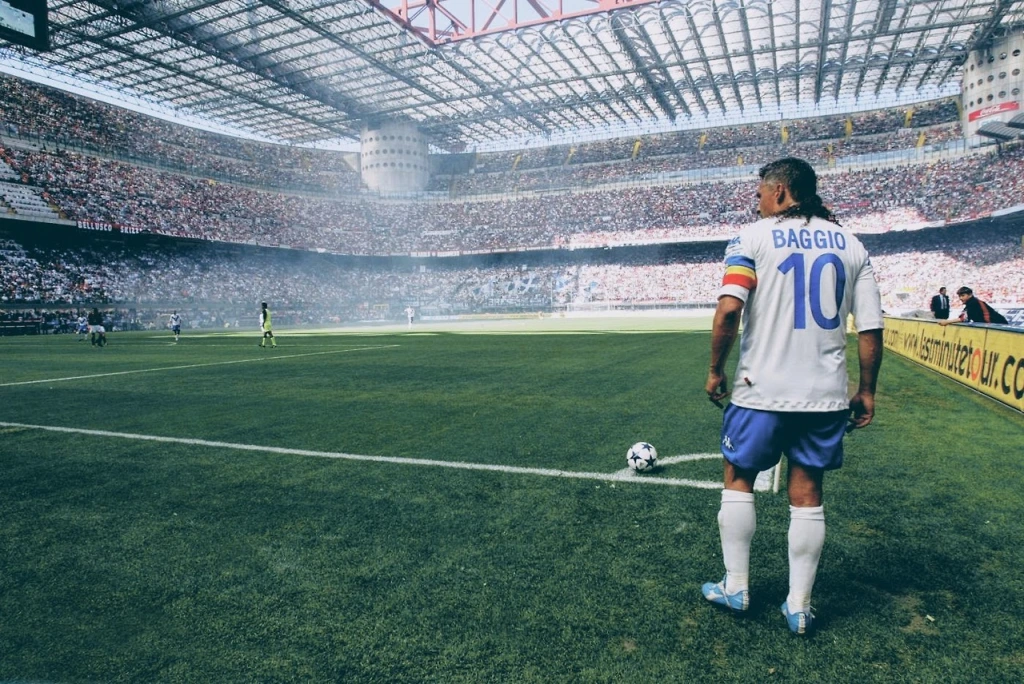
I tuned in to watch a game in 1990 and my life changed forever. A spiritual experience related to football. The world was in Italy. It was high culture, art and football. The best players from that world cup were playing in Italy already. Then all throughout the 1990’s Serie A dominated world football, in every respect. But I enjoyed the first half of the decade especially, as a young kid and before any cynicism set’s in. Before football and the balance of power started to shift more and more to the “top” team’s from each country in the 2000’s. Back then, every Serie A team had 3-6 world class ‘stranieri’ stars!
San Siro was the perfect setting. An engineering work of technological might added to atmospheric art, symbol of Italy’s dominance over the world of football. As splendid as it still is, it could do with major refurbishment work now. But I don’t believe for one instant, that with today’s technology, they couldn’t give it the glorious facelift that San Siro deserves. I just think that it’s simpler and cheaper for the old suit’s to flatten and start again. But for any fan of the sport, who has a hint of romance and football history in their soul, as well as a desire to watch it from a rare piece of genuine, football art, with an atmosphere to match, then replacing it would be yet another example of progress taking a step backward’s. Economy over heart. Go flatten some of those dilapidated stadia in the south, or do they have an “architectural significance,” as prime examples of how modern fan’s can still “enjoy” football from an open rot of a carcass? I wish and pray with every fiber of my Being that respect and common sense triumphs over ‘economic progress’ in this case! Legend’s don’t deserve to be demolished for simplicity’s sake!